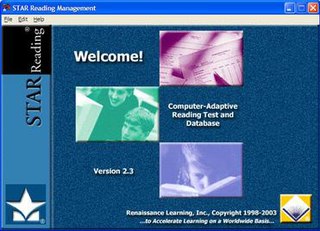Related Research Articles
The ACT is a standardized test used for college admissions in the United States. It is currently administered by ACT, a nonprofit organization of the same name. The ACT test covers four academic skill areas: English, mathematics, reading, and scientific reasoning. It also offers an optional direct writing test. It is accepted by all four-year colleges and universities in the United States as well as more than 225 universities outside of the U.S.

The SAT is a standardized test widely used for college admissions in the United States. Since its debut in 1926, its name and scoring have changed several times; originally called the Scholastic Aptitude Test, it was later called the Scholastic Assessment Test, then the SAT I: Reasoning Test, then the SAT Reasoning Test, then simply the SAT.

Psychological testing is the administration of psychological tests. Psychological tests are administered by trained evaluators. A person's responses are evaluated according to carefully prescribed guidelines. Scores are thought to reflect individual or group differences in the construct the test purports to measure. The science behind psychological testing is psychometrics.

A standardized test is a test that is administered and scored in a consistent, or "standard", manner. Standardized tests are designed in such a way that the questions and interpretations are consistent and are administered and scored in a predetermined, standard manner.
Grading in education is the process of applying standardized measurements for varying levels of achievements in a course. Grades can be assigned as letters, as a range, as a percentage, or as a number out of a possible total.
Educational assessment or educational evaluation is the systematic process of documenting and using empirical data on the knowledge, skill, attitudes, and beliefs to refine programs and improve student learning. Assessment data can be obtained from directly examining student work to assess the achievement of learning outcomes or can be based on data from which one can make inferences about learning. Assessment is often used interchangeably with test, but not limited to tests. Assessment can focus on the individual learner, the learning community, a course, an academic program, the institution, or the educational system as a whole. The word 'assessment' came into use in an educational context after the Second World War.
In psychology, ipsative measures are those where respondents compare two or more desirable options and pick the one they prefer most. Sometimes called a forced-choice scale, this measure contrasts Likert-type scales in which respondents score—often from 1 to 5—how much they agree with a given statement.
The Overall Position (OP) was a tertiary entrance rank used in Queensland, Australia to guide selection into universities. Like similar systems used throughout the rest of Australia, the OP shows how well a student has performed in their senior secondary studies compared with all other OP-eligible students in Queensland. The system was introduced in 1992 and ended with the 2019 cohort.
A criterion-referenced test is a style of test which uses test scores to generate a statement about the behavior that can be expected of a person with that score. Most tests and quizzes that are written by school teachers can be considered criterion-referenced tests. In this case, the objective is simply to see whether the student has learned the material. Criterion-referenced assessment can be contrasted with norm-referenced assessment and ipsative assessment.

STAR Reading, STAR Early Literacy and STAR Math are standardized, computer-adaptive assessments created by Renaissance Learning, Inc., for use in K-12 education. Each is a "Tier 2" assessment of a skill that can be used any number of times due to item-bank technology. These assessments fall somewhere between progress monitoring tools and high-stakes tests.
In educational statistics, a normal curve equivalent (NCE), developed for the United States Department of Education by the RMC Research Corporation, is a way of standardizing scores received on a test into a 0-100 scale similar to a percentile-rank, but preserving the valuable equal-interval properties of a z-score. It is defined as:
In an educational setting, standards-based assessment is assessment that relies on the evaluation of student understanding with respect to agreed-upon standards, also known as "outcomes". The standards set the criteria for the successful demonstration of the understanding of a concept or skill.
Germany uses a 5- or 6-point grading scale (GPA) to evaluate academic performance for the youngest to the oldest students. Grades vary from 1 to 5. In the final classes of German Gymnasium schools that prepare for university studies, a point system is used with 15 points being the best grade and 0 points the worst. The percentage causing the grade can vary from teacher to teacher.
The ECTS grading scale is a grading system defined in the European Credit Transfer and Accumulation System (ECTS) framework by the European Commission. Since many grading systems co-exist in Europe and, considering that interpretation of grades varies considerably from one country to another, if not from one institution to another, the ECTS grading scale has been developed to provide a common measure and facilitate the transfer of students and their grades between European higher education institutions, by allowing national and local grading systems to be interchangeable. Grades are reported on a carefully calibrated and uniform A-to-F scale combined with keywords and short qualitative definitions. Each institution makes its own decision on how to apply the ECTS grading scale to its system.
The Wide Range Achievement Test, currently in its fifth edition (WRAT5), is an achievement test which measures an individual's ability to read words, comprehend sentences, spell, and compute solutions to math problems.
The Bracken School Readiness Assessment ("BSRA") is an individual concept knowledge test designed for children, pre-K through second grade.
A test score is a piece of information, usually a number, that conveys the performance of an examinee on a test. One formal definition is that it is "a summary of the evidence contained in an examinee's responses to the items of a test that are related to the construct or constructs being measured."
The Criterion-Referenced Competency Tests (CRCT) were a set of tests administered at public schools in the state of Georgia that are designed to test the knowledge of first through eighth graders in reading, English/language arts (ELA), and mathematics, and third through eighth graders additionally in science and social studies.
Academic grading in the United States commonly takes on the form of five, six or seven letter grades. Traditionally, the grades are A+, A, A−, B+, B, B−, C+, C, C−, D+, D, D− and F, with A+ being the highest and F being lowest. In some cases, grades can also be numerical. Numeric-to-letter-grade conversions generally vary from system to system and between disciplines and status.

A test or examination is an educational assessment intended to measure a test-taker's knowledge, skill, aptitude, physical fitness, or classification in many other topics. A test may be administered verbally, on paper, on a computer, or in a predetermined area that requires a test taker to demonstrate or perform a set of skills.
References
- 1 2 Roell, Kelly. "What is Grading on a Curve?". About.com. Retrieved November 13, 2013.
- ↑ Cronbach, L. J. (1970). Essentials of psychological testing (3rd ed.). New York: Harper & Row.
- ↑ Glaser, R. (1963). "Instructional technology and the measurement of learning outcomes". American Psychologist. 18: 510–522. doi:10.1037/h0049294.
- ↑ Assessment
- ↑ "PDF presentation" (PDF). Archived from the original (PDF) on 2015-09-24. Retrieved 2006-07-21.
- ↑ stories 5-01.html [ permanent dead link ] Fairtest.org: Times on Testing "criterion referenced" tests measure students against a fixed yardstick, not against each other.
- ↑ "Archived copy". Archived from the original on 2010-04-14. Retrieved 2010-04-14.
{{cite web}}: CS1 maint: archived copy as title (link) Illinois Learning Standards - ↑ Volokh, Eugene (February 9, 2015). "In praise of grading on a curve". Washington Post. Retrieved 18 May 2017.
Like democracy, grading on a curve may be the worst possible system — except for all the alternatives.
- ↑ Oregon Research Institute, IPIP website, http://ipip.ori.org/newNorms.htm
- ↑ NCTM: News & Media: Assessment Issues (Newsbulletin April 2004) "by definition, half of the nation's students are below grade level at any particular moment"
- ↑ Archived 2007-03-11 at the Wayback Machine National Children's Reading Foundation website
- ↑ Reese, Michael (May 13, 2013). "To Curve or Not to Curve". The Innovative Instructor Blog. Johns Hopkins University. Retrieved May 13, 2013.